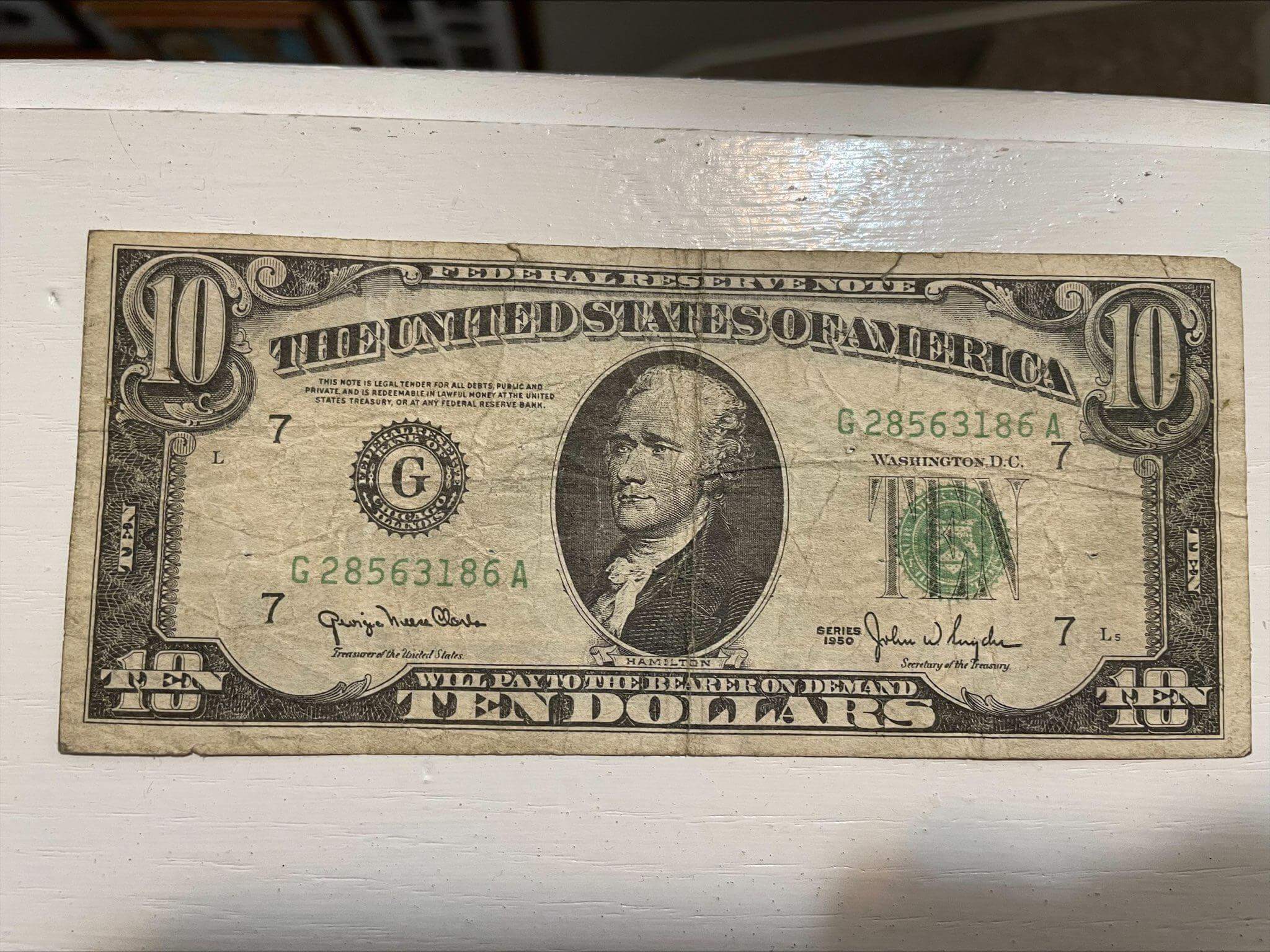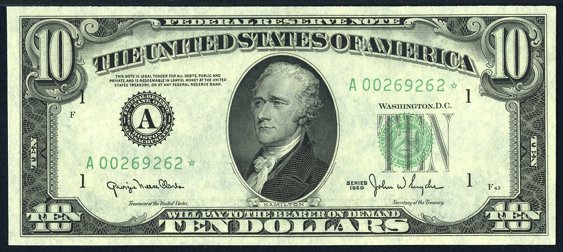If you’ve ever come across a 1950 10 dollar bill, whether tucked away in a drawer or passed down through generations, you might wonder: how much is this old piece of currency worth? While most might assume that bills from decades ago are just old paper, some of these bills can be worth a surprising amount depending on several key factors.
In this article, we’ll delve into the 1950 $10 bill’s history, variations, and current value, helping collectors and enthusiasts understand the factors that influence the worth of this classic note.
The History Of The 1950 10 Dollar Bill
The 1950 $10 bill is a part of the series of Federal Reserve Notes issued by the U.S. Treasury. This particular note was printed during a transitional time in American currency. The United States was in the midst of post-WWII reconstruction, and the economy was rapidly growing.

The design of these bills remained relatively similar to previous issues, featuring portraits of historical figures and the familiar green seal of the Federal Reserve.
The 1950 series is often a subject of interest for numismatists and currency collectors due to its historical significance and variety. It is important to note that the series of 1950 $10 bills spans multiple sub-series, including 1950, 1950A, 1950B, 1950C, 1950D, and 1950E, with each having slight variations in design and print runs that affect their value today.
Key Specifications of the 1950 $10 Bill
- Denomination: $10 USD
- Type: Federal Reserve Note
- Seal Color: Green
- Series: 1950, 1950A, 1950B, 1950C, 1950D, and 1950E
- Portrait: Alexander Hamilton (on the obverse side)
These bills were part of the United States’ regular currency circulation during the postwar period, and the design has remained one of the most iconic representations of U.S. banknotes.
The Value of the 1950 $10 Bill
The value of any collectible currency is determined by various factors, including its condition, rarity, and special characteristics like serial numbers or errors. For the 1950 $10 bill, the series and grade of the note are the most important factors to consider when estimating its value.
Condition (Grading System)
Before diving into values, it’s important to understand how condition impacts the price. Banknotes are graded based on their appearance and wear. There are two primary grades for the 1950 $10 bill:
- Extremely Fine (EF): These bills show signs of having been in circulation, such as slight creases or folds. The note retains much of its original crispness and is free from stains, tears, or heavy discoloration. Bills in this grade are usually worth less than uncirculated bills but still fetch a premium compared to heavily worn notes.
- Choice Uncirculated (MS 63): These bills show no signs of wear and have remained in pristine condition. The note retains its original crispness, with no folds or creases, and is often well-centered. Uncirculated bills are the most valuable of the bunch.
Standard 1950 $10 Bills: Value Breakdown
Let’s explore how the different series of the 1950 $10 bill are valued based on their condition and rarity.
- 1950 Series: The standard 1950 $10 bills are worth approximately $20 in extremely fine condition. For bills in uncirculated condition with an MS 63 grade, the price can rise to around $67.50. Notably, bills from the Federal Reserve Bank of Minneapolis tend to fetch slightly higher prices.
- 1950A Series: Similar to the 1950 series, most 1950A bills are worth about $20 in extremely fine condition. Uncirculated notes (MS 63) can reach a value of around $70 to $80.
- 1950B Series: These are generally worth around $17.50 in extremely fine condition. In uncirculated condition, the price can range from $35 to $45.
- 1950C Series: In extremely fine condition, these bills are valued at around $17.50, with uncirculated notes going for about $45 to $47.50.
- 1950D Series: The 1950D notes tend to be a little less valuable, with extremely fine examples worth about $15. Uncirculated bills (MS 63) can be priced between $40 and $50.
- 1950E Series: The 1950E $10 bill is one of the more valuable standard notes in the series, with bills in extremely fine condition fetching approximately $52.50. Uncirculated examples can command around $100.
Star Notes: A Special Category
If you’ve ever noticed a star symbol at the end of a bill’s serial number, you’ve come across a **Star Note**. These are replacement bills issued by the Federal Reserve when a note in a previous series was found to be defective during production.
Because Star Notes are rarer than regular notes, they are typically more valuable.

For the 1950 $10 bill, Star Notes from various series and Federal Reserve Banks hold additional value. Let’s take a closer look at their worth:
- 1950 Series Star Notes: In extremely fine condition, these can be worth anywhere from $50 to $70, and uncirculated Star Notes can fetch up to $450.
- 1950A Series Star Notes: Generally valued around $45 to $50 in extremely fine condition. Uncirculated notes can range from $245 to $325.
- 1950B Series Star Notes: In extremely fine condition, these notes can be worth around $65, and uncirculated Star Notes can fetch up to $150.
- 1950C Series Star Notes: These are typically valued at $55 in extremely fine condition, and uncirculated examples can range from $175 to $250.
- 1950D Series Star Notes: Star notes from this series are worth approximately $60 in extremely fine condition, and uncirculated notes typically range from $175 to $200.
- 1950E Series Star Notes: These are among the most valuable, with prices around $115 for bills in extremely fine condition. In uncirculated condition, they can fetch up to $350.
Additionally, Star Notes from certain Federal Reserve Banks (such as those from Atlanta, Minneapolis, and Richmond) can often be more valuable than others due to their rarity.
What Makes a 1950 $10 Bill Special?
Several factors can make a 1950 $10 bill even more valuable, including:
- Serial Numbers: Bills with unique or low serial numbers (e.g., all zeros, low numbers, or repeating digits) can command a premium.
- Errors and Misprints: Some notes may have printing errors or other anomalies, which can significantly increase their value. These could include off-center printing, misaligned serial numbers, or even missing printing altogether.
- Historical Significance: The 1950 $10 bill was part of the post-WWII economic boom and a transitional period for U.S. currency. As such, it holds historical significance for collectors interested in currency history.
The Inflation Perspective: What $10 in 1950 Was Worth
While it’s interesting to collect these notes for their value today, it’s equally important to consider what $10 in 1950 could buy. Adjusted for inflation, $10 in 1950 is equivalent to about $101.71 in 2017, reflecting a dramatic increase in the cost of goods over nearly seven decades.
This makes the 1950 $10 bill a fascinating snapshot of the U.S. economy in the early 1950s.
Conclusion
A seasoned numismatist or just beginning to explore the world of currency collecting, the 1950 $10 bill offers both historical intrigue and the potential for financial gain. The series features a range of values based on condition, series, and rarity, with Star Notes especially commanding higher prices.
If you have one of these bills in your collection, it’s essential to properly store and preserve it to maintain its condition. As with any collectible, the value of a 1950 10 dollar bill can fluctuate based on market trends, but for those with a keen interest in U.S. currency history, these notes are a valuable and rewarding piece of Americana.
